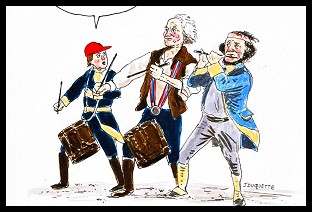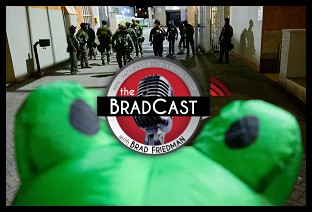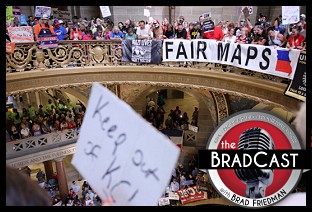 After failing to count votes accurately in a number of recent elections in FL, NJ, and D.C., a report has now been released by the D.C. Board of Elections noting that, as it turns out, Michelle Shafer, official mouthpiece for both Sequoia Voting Systems and the election industry's PR outfit, Election Technology Council (ETC), has once again been misleading the public about Sequoia's bad voting equipment --- both touch-screen and paper ballot systems --- and the fact that they don't work.
After failing to count votes accurately in a number of recent elections in FL, NJ, and D.C., a report has now been released by the D.C. Board of Elections noting that, as it turns out, Michelle Shafer, official mouthpiece for both Sequoia Voting Systems and the election industry's PR outfit, Election Technology Council (ETC), has once again been misleading the public about Sequoia's bad voting equipment --- both touch-screen and paper ballot systems --- and the fact that they don't work.
The D.C. Board released its report on its investigation into an incident from last month's primary where some 1,500 phantom votes were recorded on Sequoias tabulator after being uploaded from a paper ballot system. There should have been just over 300 votes, instead of thousands, from Precinct 141.
 Shafer had originally claimed (as usual) human error and static electricity were to blame. When the incident was first discovered in September, Shafer told the Washington Post: "There's absolutely no problem with the machines in the polling places. No. No."
Shafer had originally claimed (as usual) human error and static electricity were to blame. When the incident was first discovered in September, Shafer told the Washington Post: "There's absolutely no problem with the machines in the polling places. No. No."
Turns out, Shafer lied. Again. As the D.C. report notes Sequoia was "too quick to exonerate itself and the equipment used in the tabulation process" and that "the evidence appears to indicate that there was a problem both in equipment (the server) and in the software"...
Last month, the Computer Security Group at UC Santa Barbara released a video showing exactly how to hack a touch-screen Sequoia voting system --- in such a way that even a manual count of the system's "paper trails" would not have revealed the hack. In 2006, just days before the general elections, The BRAD BLOG revealed how a yellow button on the back of Sequoia's touch-screen systems could be pressed in such a way as to allow any voter to vote as many times as he/she liked.
Sequoia is America's number three voting equipment vendor, allowed to do business in 17 states, including D.C. The same machines that have been failing spectacularly in recent primary elections will be used again, as is, in this November 4th's general election. Even the yellow buttons are still there.
The incident in D.C., however (as well as the one in Palm Beach County, FL, where their op-scan systems were unable to count the same ballots the same way twice!) was on one of the company's paper ballot electronic voting systems. From WaPo late last week [emphasis added]...
The report dismisses Sequoias theories that human error or static discharge, not defective software or hardware, was at fault when a cartridge from Precinct 141 added thousands of votes. It commits the special committee to examine the effectiveness of the three-member elections board and its top staff.
But those issues cannot be resolved before the Nov. 4 election, which officials expect will draw a record number of voters. The committees recommendations include actions to be taken Election Day.
A significant step is to train poll workers to persuade voters to use optical-scan machines instead of electronic touch-screen ones, although the primary night blunder has been traced to a cartridge from an optical-scan machine.


 Sunday 'Close Enough' Toons
Sunday 'Close Enough' Toons A Pretty Weak 'Strongman': 'BradCast' 10/30/25
A Pretty Weak 'Strongman': 'BradCast' 10/30/25 'Green News Report' 10/30/25
'Green News Report' 10/30/25
 Proposal for 'First Politically Viable Wealth Tax' Takes Shape in CA: 'BradCast' 10/29/25
Proposal for 'First Politically Viable Wealth Tax' Takes Shape in CA: 'BradCast' 10/29/25 Monster Storm, Endless Wars, Gamed Elections:
Monster Storm, Endless Wars, Gamed Elections: 'Green News Report' 10/28/25
'Green News Report' 10/28/25 Let's Play 'Who Wants
Let's Play 'Who Wants Sunday 'Cartoonists Dilemma' Toons
Sunday 'Cartoonists Dilemma' Toons Exiled NOAA Scientists Resurrect Critical Disaster Database: 'BradCast' 10/23/25
Exiled NOAA Scientists Resurrect Critical Disaster Database: 'BradCast' 10/23/25  'Green News Report' 10/23/25
'Green News Report' 10/23/25 Trump-Allied GOP Partisan Buys Dominion Voting Systems: 'BradCast' 10/22/25
Trump-Allied GOP Partisan Buys Dominion Voting Systems: 'BradCast' 10/22/25 Trump, Republican Law(lessness) & (Dis)Order: 'BradCast' 10/21/25
Trump, Republican Law(lessness) & (Dis)Order: 'BradCast' 10/21/25 'Green News Report' 10/21/25
'Green News Report' 10/21/25 Celebrating 'No Kings': 'BradCast' 10/20/25
Celebrating 'No Kings': 'BradCast' 10/20/25 Sunday 'How It Started' Toons
Sunday 'How It Started' Toons SCOTUS Repubs Appear Ready to Gut Rest of Voting Rights Act: 'BradCast' 10/16/25
SCOTUS Repubs Appear Ready to Gut Rest of Voting Rights Act: 'BradCast' 10/16/25 'Green News Report' 10/16/25
'Green News Report' 10/16/25 The 'Epstein Shutdown' and Other Autocratic Nightmares: 'BradCast' 10/15/25
The 'Epstein Shutdown' and Other Autocratic Nightmares: 'BradCast' 10/15/25 Group Vows to Block MO's GOP U.S. House Gerrymander: 'BradCast' 10/14/25
Group Vows to Block MO's GOP U.S. House Gerrymander: 'BradCast' 10/14/25 Trump Labor Dept. Warns Trump Policies Sparking Food Crisis: 'BradCast' 10/9/25
Trump Labor Dept. Warns Trump Policies Sparking Food Crisis: 'BradCast' 10/9/25 Trump's Losing Battles: 'BradCast' 10/8/25
Trump's Losing Battles: 'BradCast' 10/8/25 Trump, Roberts and His Stacked, Packed and Captured SCOTUS: 'BradCast' 10/7/25
Trump, Roberts and His Stacked, Packed and Captured SCOTUS: 'BradCast' 10/7/25 Trump Attempting His 'Invasion from Within': 'BradCast' 10/6/25
Trump Attempting His 'Invasion from Within': 'BradCast' 10/6/25 Biden Budget Expert: Mass Firings in Shutdown 'Illegal': 'BradCast' 10/2/25
Biden Budget Expert: Mass Firings in Shutdown 'Illegal': 'BradCast' 10/2/25 Why is DOJ Suing 'Blue' States for Their Voter Databases?: 'BradCast' 10/1/25
Why is DOJ Suing 'Blue' States for Their Voter Databases?: 'BradCast' 10/1/25
 VA GOP VOTER REG FRAUDSTER OFF HOOK
VA GOP VOTER REG FRAUDSTER OFF HOOK Criminal GOP Voter Registration Fraud Probe Expanding in VA
Criminal GOP Voter Registration Fraud Probe Expanding in VA DOJ PROBE SOUGHT AFTER VA ARREST
DOJ PROBE SOUGHT AFTER VA ARREST Arrest in VA: GOP Voter Reg Scandal Widens
Arrest in VA: GOP Voter Reg Scandal Widens ALL TOGETHER: ROVE, SPROUL, KOCHS, RNC
ALL TOGETHER: ROVE, SPROUL, KOCHS, RNC LATimes: RNC's 'Fired' Sproul Working for Repubs in 'as Many as 30 States'
LATimes: RNC's 'Fired' Sproul Working for Repubs in 'as Many as 30 States' 'Fired' Sproul Group 'Cloned', Still Working for Republicans in At Least 10 States
'Fired' Sproul Group 'Cloned', Still Working for Republicans in At Least 10 States FINALLY: FOX ON GOP REG FRAUD SCANDAL
FINALLY: FOX ON GOP REG FRAUD SCANDAL COLORADO FOLLOWS FLORIDA WITH GOP CRIMINAL INVESTIGATION
COLORADO FOLLOWS FLORIDA WITH GOP CRIMINAL INVESTIGATION CRIMINAL PROBE LAUNCHED INTO GOP VOTER REGISTRATION FRAUD SCANDAL IN FL
CRIMINAL PROBE LAUNCHED INTO GOP VOTER REGISTRATION FRAUD SCANDAL IN FL Brad Breaks PA Photo ID & GOP Registration Fraud Scandal News on Hartmann TV
Brad Breaks PA Photo ID & GOP Registration Fraud Scandal News on Hartmann TV  CAUGHT ON TAPE: COORDINATED NATIONWIDE GOP VOTER REG SCAM
CAUGHT ON TAPE: COORDINATED NATIONWIDE GOP VOTER REG SCAM CRIMINAL ELECTION FRAUD COMPLAINT FILED AGAINST GOP 'FRAUD' FIRM
CRIMINAL ELECTION FRAUD COMPLAINT FILED AGAINST GOP 'FRAUD' FIRM RICK SCOTT GETS ROLLED IN GOP REGISTRATION FRAUD SCANDAL
RICK SCOTT GETS ROLLED IN GOP REGISTRATION FRAUD SCANDAL VIDEO: Brad Breaks GOP Reg Fraud Scandal on Hartmann TV
VIDEO: Brad Breaks GOP Reg Fraud Scandal on Hartmann TV RNC FIRES NATIONAL VOTER REGISTRATION FIRM FOR FRAUD
RNC FIRES NATIONAL VOTER REGISTRATION FIRM FOR FRAUD EXCLUSIVE: Intvw w/ FL Official Who First Discovered GOP Reg Fraud
EXCLUSIVE: Intvw w/ FL Official Who First Discovered GOP Reg Fraud GOP REGISTRATION FRAUD FOUND IN FL
GOP REGISTRATION FRAUD FOUND IN FL

































